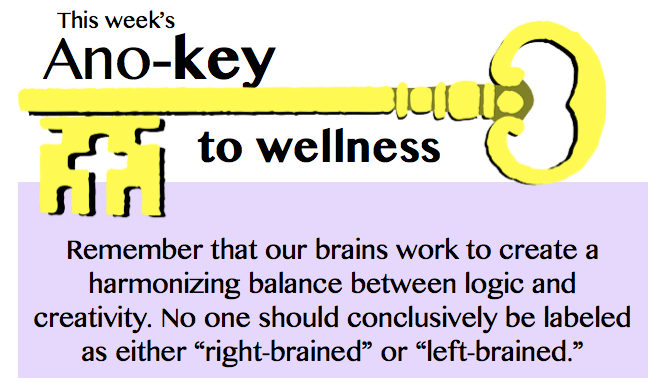LiveWell: Balance of the Brain
I stared at the question on my laptop screen, wracking my brain for an answer. No, of course I don’t waste my time doing that…or, wait…maybe I do. Frustration and confusion clogged my mind as I wondered how in the world this test could possibly classify all the complexities and intricacies of my brain into one of two categories: right-brained or left-brained.
As I was sorting through my email last week, I came across an advertisement for a “Right-Brained or Left-Brained?” test. I clicked on the link and answered 28 questions about my interests and instincts. At the end, my test concluded that I was left-brained, meaning that I most often solve problems through logic, mathematics, verbal language, and fact-based knowledge, as opposed to creativity, imagination, and visualization.
As a person who engages in the arts (although I’m no Van Gogh), this came as a slight surprise. Yes, I love the objectivity of numbers, but I also have a creative side, as an avid dancer.
My results only made me more curious to see whether my friends were right or left brain-dominant. Just as I expected, many of my peers, whom I considered to be artistically or creatively proficient received “left brain” results, and vice versa.
As I took more and more versions of these tests, I began to think. How can we label people as being right or left-brained, when most of what we do requires both logic and creativity? At first glance, programming, calculus, and chemistry may seem to be exclusively “left-brained” subjects, with only black and white reasoning. However, when we look deeper, we can see that creativity and imagination are involved in finding the most effective algorithm to code for a program or the most efficient method to solve an equation. Whether it’s drawing a picture or memorizing vocabulary words, both sides of the brain are incorporated. Some of us may be more organized than others and some of us may choose an art class over a math class, but in the end, 28 questions cannot put a label on us.
The science behind the left-brain – right-brain principle arose with the research of Roger W. Sperry in 1981. He found that different tasks are performed in specialized regions in different sides of the brain. However, since then, his experiments have been exaggerated and misconstrued by the public, especially in the form of these online psychological quizzes.
Sure, color may be processed in our right brains and words in our left, but I think that all major decisions require a harmonizing communication between both sides. In the future, no matter what professions we end up in, we will experience situations that will require both sides of our brain – intuition and analysis, images and words, emotion and language.
Anokhi Saklecha (12) is the Global Editor for the Winged Post. She has been in the journalism program for the past three years. She loves the creativity,...


















![“[Building nerf blasters] became this outlet of creativity for me that hasn't been matched by anything else. The process [of] making a build complete to your desire is such a painstakingly difficult process, but I've had to learn from [the skills needed from] soldering to proper painting. There's so many different options for everything, if you think about it, it exists. The best part is [that] if it doesn't exist, you can build it yourself," Ishaan Parate said.](https://harkeraquila.com/wp-content/uploads/2022/08/DSC_8149-900x604.jpg)




![“When I came into high school, I was ready to be a follower. But DECA was a game changer for me. It helped me overcome my fear of public speaking, and it's played such a major role in who I've become today. To be able to successfully lead a chapter of 150 students, an officer team and be one of the upperclassmen I once really admired is something I'm [really] proud of,” Anvitha Tummala ('21) said.](https://harkeraquila.com/wp-content/uploads/2021/07/Screen-Shot-2021-07-25-at-9.50.05-AM-900x594.png)







![“I think getting up in the morning and having a sense of purpose [is exciting]. I think without a certain amount of drive, life is kind of obsolete and mundane, and I think having that every single day is what makes each day unique and kind of makes life exciting,” Neymika Jain (12) said.](https://harkeraquila.com/wp-content/uploads/2017/06/Screen-Shot-2017-06-03-at-4.54.16-PM.png)








![“My slogan is ‘slow feet, don’t eat, and I’m hungry.’ You need to run fast to get where you are–you aren't going to get those championships if you aren't fast,” Angel Cervantes (12) said. “I want to do well in school on my tests and in track and win championships for my team. I live by that, [and] I can do that anywhere: in the classroom or on the field.”](https://harkeraquila.com/wp-content/uploads/2018/06/DSC5146-900x601.jpg)
![“[Volleyball has] taught me how to fall correctly, and another thing it taught is that you don’t have to be the best at something to be good at it. If you just hit the ball in a smart way, then it still scores points and you’re good at it. You could be a background player and still make a much bigger impact on the team than you would think,” Anya Gert (’20) said.](https://harkeraquila.com/wp-content/uploads/2020/06/AnnaGert_JinTuan_HoHPhotoEdited-600x900.jpeg)

![“I'm not nearly there yet, but [my confidence has] definitely been getting better since I was pretty shy and timid coming into Harker my freshman year. I know that there's a lot of people that are really confident in what they do, and I really admire them. Everyone's so driven and that has really pushed me to kind of try to find my own place in high school and be more confident,” Alyssa Huang (’20) said.](https://harkeraquila.com/wp-content/uploads/2020/06/AlyssaHuang_EmilyChen_HoHPhoto-900x749.jpeg)



